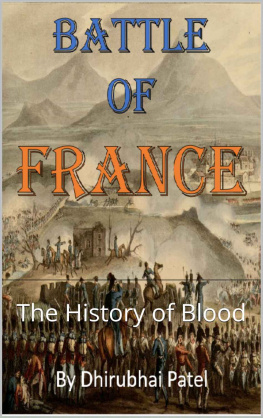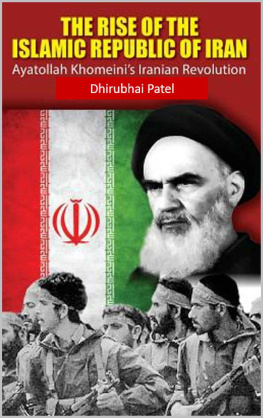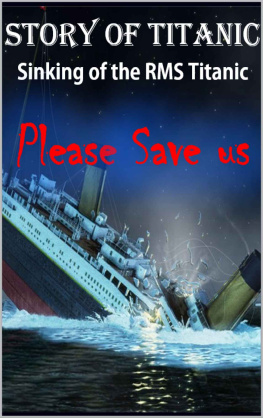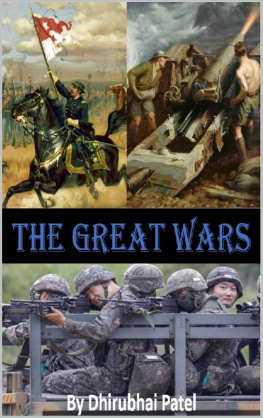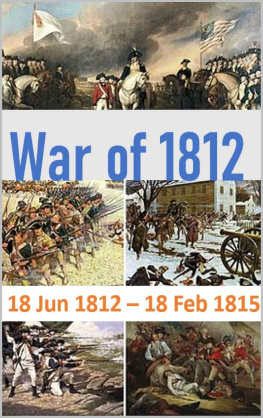Patel - Battle of France
Here you can read online Patel - Battle of France full text of the book (entire story) in english for free. Download pdf and epub, get meaning, cover and reviews about this ebook. year: 2020, genre: Non-fiction. Description of the work, (preface) as well as reviews are available. Best literature library LitArk.com created for fans of good reading and offers a wide selection of genres:
Romance novel
Science fiction
Adventure
Detective
Science
History
Home and family
Prose
Art
Politics
Computer
Non-fiction
Religion
Business
Children
Humor
Choose a favorite category and find really read worthwhile books. Enjoy immersion in the world of imagination, feel the emotions of the characters or learn something new for yourself, make an fascinating discovery.
- Book:Battle of France
- Author:
- Genre:
- Year:2020
- Rating:3 / 5
- Favourites:Add to favourites
- Your mark:
- 60
- 1
- 2
- 3
- 4
- 5
Battle of France: summary, description and annotation
We offer to read an annotation, description, summary or preface (depends on what the author of the book "Battle of France" wrote himself). If you haven't found the necessary information about the book — write in the comments, we will try to find it.
Patel: author's other books
Who wrote Battle of France? Find out the surname, the name of the author of the book and a list of all author's works by series.
Battle of France — read online for free the complete book (whole text) full work
Below is the text of the book, divided by pages. System saving the place of the last page read, allows you to conveniently read the book "Battle of France" online for free, without having to search again every time where you left off. Put a bookmark, and you can go to the page where you finished reading at any time.
Font size:
Interval:
Bookmark:
Battle of France
Chapter 1 : Story of War
Chapter 2 : Maginot Line
2.1 Planning and construction
2.2 1927: Allied Control Commission abolished
2.3 German economic superiority
2.4 War of long duration
2.5 Manning
2.6 Organization
2.7 Inventory
2.8 Features
2.9 German invasion in World War II
2.10 Post-war assessment
Chapter 3 : Invasion of Poland
3.1 Breakdown of talks
3.2 Opposing forces
3.3 Details
3.4 Aftermath
3.5 Eyewitness accounts
3.6 Misconceptions
3.7 First use of Blitzkrieg strategy
Chapter 4 : Phoney War
4.1 German strategy
4.2 Manstein Plan
4.3 Mechelen incident
4.4 Allied strategy
4.5 Dyle Plan/Plan D
Chapter : 5 Prelude
5.1 Luftwaffe
5.2 Battle
5.3 Weygand Plan
5.4 BEF and the Channel ports
5.5 Fall Rot
5.6 Second BEF evacuation
5.7 Battle of the Alps
5.8 Armistice
5.9 Aftermath
5.10 Occupation
Battle of France
Chapter 1: Story of War
The Battle of France, otherwise called the Fall of France, was the German invasion of France and the Low Countries during the Second World War. On 3 September 1939 France had proclaimed war on Germany, following the German invasion of Poland. Toward the beginning of September 1939, France started the restricted Saar Offensive. By mid-October, the French had pulled back to their beginning lines. In about a month and a half from 10 May 1940, German forces crushed Allied forces by portable tasks, vanquishing France, Belgium, Luxembourg and the Netherlands, finishing land procedure on the Western Front until the Normandy arrivals on 6 June 1944. Italy entered the war on 10 June 1940.
In Fall Gelb (Case Yellow), German heavily clad units made an unexpected push through the Ardennes, and afterward along the Somme valley, cutting off and encompassing the Allied units that had progressed into Belgium to meet the normal German invasion. English, Belgian and French forces were pushed back to the ocean by the German militaries and the British emptied the British Expeditionary Force (BEF), French and Belgian soldiers from Dunkirk in Operation Dynamo.
German forces started Fall Rot (Case Red) on 5 June. The sixty staying French divisions and the two British divisions in France made a decided remain on the Somme and Aisne yet were vanquished by the German mix of air predominance and protected versatility. German tanks defeated the Maginot Line and drove profound into France, involving Paris unopposed on 14 June. After the trip of the French government and the breakdown of the French Army, German commandants met with French officials on 18 June to arrange a conclusion to threats.
On 22 June, the Second Armistice at Compigne was marked by France and Germany. The nonpartisan Vichy government drove by Marshal Philippe Ptain supplanted the Third Republic and Germany involved the North Sea and Atlantic shores of France and their hinterlands. The Italian invasion of France over the Alps took a limited quantity of ground and after the peace negotiation Italy involved a little occupation zone in the south-east. The Vichy system held the empty region in the south (zone libre). In November 1942, the Germans and Italians involved the zone under Case Anton (Fall Anton), until the Allied freedom in 1944.
Chapter 2 : Maginot Line
The Maginot Line named after the French Minister of War Andr Maginot, is a line of solid strongholds, deterrents, and weapon establishments worked by France during the 1930s to deflect invasion by Germany and power them to move around the fortresses.
The Maginot Line was impenetrable to most types of assault. In any case, the Germans attacked through the Low Countries in 1940, bypassing the Line toward the north. The line has since gotten an analogy for costly endeavors that offer a misguided feeling of security.
Developed on the French side of its fringes with Italy, Switzerland, Germany, and Luxembourg, the line didn't reach out to the English Channel because of French methodology that imagined a move into Belgium to counter a German attack. In light of France's involvement in close quarters conflict during World War I, the huge Maginot Line was underlying the approach World War II, after the Locarno Conference offered ascend to a whimsical and hopeful "Locarno soul". French military specialists praised the Line as a work of virtuoso that would hinder German hostility, since it would slow an invasion power long enough for French forces to activate and counterattack.
The Maginot Line was safe to elevated bombings and tank fire and had underground railroads as a reinforcement; it additionally had best in class day to day environments for posted soldiers, providing cooling and eating regions for their comfort. French and British officers had foreseen the geological furthest reaches of the Maginot Line; when Germany attacked the Netherlands and Belgium, they completed designs to frame a forceful front that slice across Belgium and associated with the Maginot Line.
Nonetheless, the French line was feeble close to the Ardennes backwoods. Marshal Maurice Gamelin, when drafting the Dyle Plan, accepted this area, with its unpleasant territory, would be an improbable invasion course of German forces; on the off chance that it were crossed, it would be done at a moderate rate that would permit the French chance to raise saves and counterattack. The German Army, having reformulated their arrangements from a rehash of the First World War-time plan, got aware of and abused this frail point in the French protective front. A fast development through the backwoods and over the River Meuse enclosed a significant part of the Allied forces, bringing about a sizeable power being emptied at Dunkirk leaving the forces toward the south incapable to mount a successful protection from the German invasion of France.
The Maginot Line was worked to satisfy a few purposes:
To forestall a German shock assault.
To dissuade a cross-fringe assault.
To secure Alsace and Lorraine (got back to France in 1918) and their modern basin.
To spare labor (France checked 39 million occupants, Germany 70 million)
To spread the activation of the French Army (which took somewhere in the range of two and three weeks)
To drive Germany into a push to dodge by means of Switzerland or Belgium, and permit France to ward the following war off French soil to stay away from a rehash of 19141918.
To be utilized as a reason for a counter-offensive.
2.1 Planning and construction
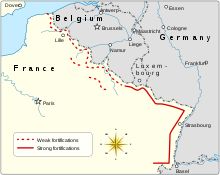
The Maginot Line
The safeguards were first proposed by Marshal Joseph Joffre. He was restricted by innovators, for example, Paul Reynaud and Charles de Gaulle, who supported interest in reinforcement and airplane. Joffre had uphold from Marshal Henri Philippe Ptain, and there were various reports and commissions composed by the legislature. It was Andr Maginot who at long last persuaded the legislature to put resources into the plan. Maginot was another veteran of World War I; he turned into the French Minister of Veteran Affairs and afterward Minister of War (19281932).
In January 1923, after Weimar Germany defaulted on reparations, the French Premier Raymond Poincar reacted by sending French soldiers to involve Germany's Ruhr area. During the resulting Ruhrkampf ("Ruhr battle") between the Germans and the French that went on until September 1923, Britain denounced the French control of the Ruhr, and a time of continued Francophobia broke out in Britain, with Poincar being criticized in Britain as a brutal harasser rebuffing Germany with irrational reparations requests. The Britishwho transparently supported the German situation on reparationsapplied extraordinary monetary weight on France to change its approaches towards Germany. At a meeting in London in 1924 to settle the Franco-German emergency brought about by the Ruhrkampf, the British Prime Minister Ramsay MacDonald effectively squeezed the French Premier douard Herriot to make concessions to Germany. The British representative Sir Eric Phipps who went to the gathering remarked afterwards that:
Next pageFont size:
Interval:
Bookmark:
Similar books «Battle of France»
Look at similar books to Battle of France. We have selected literature similar in name and meaning in the hope of providing readers with more options to find new, interesting, not yet read works.
Discussion, reviews of the book Battle of France and just readers' own opinions. Leave your comments, write what you think about the work, its meaning or the main characters. Specify what exactly you liked and what you didn't like, and why you think so.

